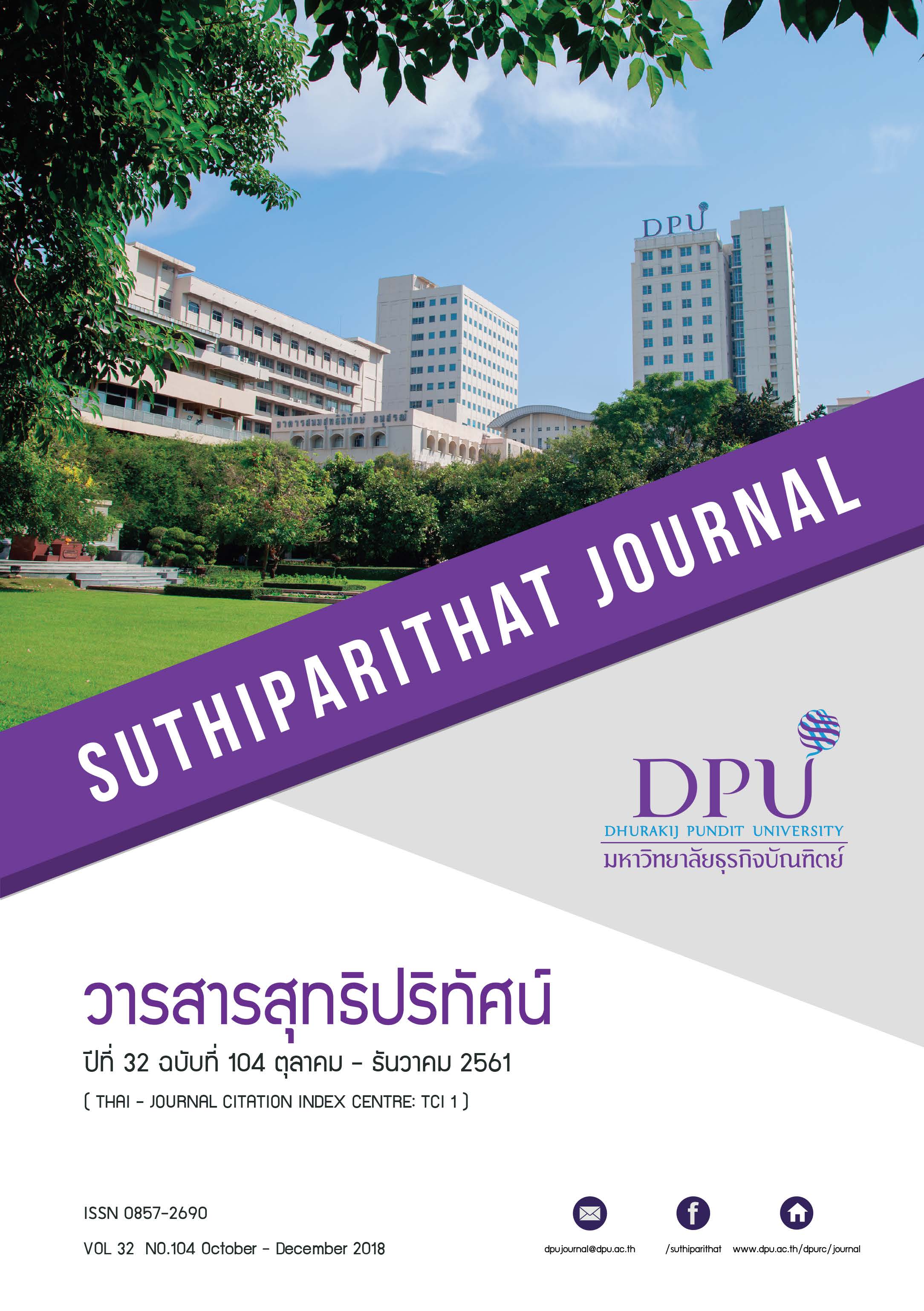ปัจจัยที่ส่งผลต่อการลงทุนโดยตรงของจีนในไทยเปรียบเทียบกับประเทศเพื่อนบ้านอาเซียนระหว่างปี 2543 – 2559
คำสำคัญ:
การลงทุนโดยตรงต่างประเทศของจีน, อาเซียน, ปัจจัยการลงทุนโดยตรงต่างประเทศบทคัดย่อ
การศึกษานี้มีจุดมุ่งหมายที่จะศึกษาการลงทุนโดยตรงของจีนในไทยเปรียบเทียบกับประเทศสมาชิกอาเชียน เนื่องจากในปัจจุบันจีนขยายการลงทุนโดยตรงในอาเซียนเพิ่มขึ้นเป็นอย่างมากโดยเฉพาะ อย่างยิ่งจากการที่อาเซียนมีการพัฒนาขึ้นเป็นประชาคมอาเซียน (ASEAN Community: AC) ตั้งแต่ปี 2558 ทำให้ขนาดเศรษฐกิจของกลุ่มอาเซียนจัดเป็นอันดับที่ 7 ของโลก ประชากรภายในกลุ่ม 625 ล้านคน มากกว่าประชากรของกลุ่มอเมริกาเหนือ หรือกลุ่มสหภาพยุโรป และอาเซียนยังมีจำนวนแรงงานเป็นอันดับ 3 ของโลกซึ่งเป็นรองเพียงจีนและอินเดีย ทำให้กลุ่มอาเซียนมีความน่าสนใจอย่างมากต่อประเทศต่างๆ โดยเฉพาะอย่างยิ่งสำหรับจีน ซึ่งเป็นประเทศที่มีการขยายตัวอย่างมากในการลงทุนโดยตรงต่างประเทศ (FDI) ดังนั้นวัตถุประสงค์ของการวิจัยนี้มี 2 ประการ ประการแรกเพื่อศึกษาการทำ FDI ของจีนในไทยเปรียบเทียบกับประเทศอื่น ๆ ในอาเซียน และประการที่ 2 เพื่อศึกษาปัจจัยที่มีผลต่อระดับการ เข้ามาทำ FDI ของจีนในอาเซียน การศึกษาครั้งนี้ใช้วิธีการเก็บข้อมูลและวิเคราะห์ด้วยสถิติเชิงพรรณา ได้แก่ ร้อยละและค่าเฉลี่ย และศึกษาความสัมพันธ์ด้วยสมการถดถอยพหุคูณ ผลการศึกษาพบว่าปัจจัยที่มีความสัมพันธ์กับการทำ FDI ของจีนในอาเซียนประกอบด้วย 8 ปัจจัยจาก 13 ปัจจัยที่ทำการศึกษา และการทำ FDI ของจีนในไทยมีความสัมพันธ์เพียง 3 ปัจจัย ดังนั้นงานวิจัยมีข้อเสนอแนะว่าภาครัฐควรให้ความสำคัญมากขึ้นใน 3 ปัจจัย คือ การเปิดเสรีทางการค้ากับจีน จำนวนนักท่องเที่ยวจีน และจำนวน ผู้ใช้อินเตอร์เน็ตของไทย เพื่อให้นักลงทุนจีนได้เห็นถึงโอกาสในการดำเนินธุรกิจ และส่งผลต่อการทำ FDI ของจีนในไทยมากขึ้น
เอกสารอ้างอิง
ชลิดา แท่งเพ็ชร และวรินี วงศ์อุไร. (2560). เส้นทางการลงทุนจากแดนมังกร FAQ ISSUE 116. สืบค้น 25 กรกฏาคม 2561, จาก https://www.bot.or.th/Thai/MonetaryPolicy/ArticleAndResearch/FAQ
ดารบุษป์ ปภาพจน์. (2560). ทำไมจึงต้อง CLMV. สืบค้น 15 กันยายน 2561, จาก http://www.bangkokbiznews.com/blog/detail/640645
ทีมข่าวต่างประเทศ. (2559, 21 ตุลาคม). ฟิลิปปินส์แจงวุ่น ยันสัมพันธ์สหรัฐยังคงเดิม ชี้แค่ไม่ต้องการพึ่งพาชาติตะวันตกมากเกินไป. สืบค้น 15 กันยายน 2561, จาก https://www.matichon.co.th/foreign/news_330842
พรรณพิไล นาคธน. (2559, 16 กรกฎาคม). แผนที่เส้นประ 9 เส้น ปฐมบทแห่งความขัดแย้งในทะเลจีนใต้. สืบค้น 15 กันยายน 2561, จาก https://mgronline.com/china/detail/9590000069661
ภาคย์ บุญนุช. (2557). จีนทุ่มซื้อโลก ปัจจัยและเบื้องหลังการลงทุนโดยตรงในต่างประเทศของจีน, ศูนย์วิจัยยุทธศาสตร์ไทย - จีน สำนักงานคณะกรรมการวิจัยแห่งชาติ. สืบค้น 8 พฤษภาคม 2561,จาก http://www.vijaichina.com
สยามรัฐสัปดาห์วิจารณ์. (2560). ทุนจีนกินรวบอาเซียนตั้งแต่เศรษฐกิจโครงสร้างยันค้าปลีก. สืบค้น 15 กันยายน 2561, จาก iQ NewsClip. 64(50), 23
อัทธ์ พิศาลวานิช. (2561). มาเลเซียทบทวนลงทุนจีน, คอลัมน์ ASEAN. สืบค้น 15 กันยายน 2561, จาก https://www.posttoday.com/aec/column/556789
China Xinhua NEWS. (2559, 1 พฤศจิกายน). นายกรัฐมนตรีมาเลเซียชี้จีนเป็นมิตรแท้ และหุ้นส่วนที่ดี. สืบค้น 15 กันยายน 2561, จาก https://www.facebook.com/XinhuaNewsAgency.th/posts
CRI online. (2559, 12 สิงหาคม). จีนเพิ่มการลงทุนในอินโดนีเซียมากขึ้น ช่วยพัฒนาโครงสร้างพื้นฐาน. สืบค้น 15 กันยายน 2561, จาก http://thai.cri.cn/247/2016/08/12/223s244957.html
Agarwal, J. P. (1980). Determinants of foreign direct investment: A survey. Review of World Economics, 116(4), 739 – 773.
Ahmad, F., Draz, M. A., & Su, C. Y. (2018). What drives OFDI? Comparative evidence from ASEAN and selected Asian economies. Journal of Chinese Economic and Foreign Trade Studies, 11(1), 15-31.
ASEAN STATISTICAL YEARBOOK. (2017), Jakarta, ASEAN Secretariat, December 2017. Retrieved April 22, 2018, from https://www.aseanstats.org/ebooks/ebook
Bosco, M. G. (2001). Does FDI contribute to technological spillovers and growth? A panel data analyses of Hungarian firms. Transnational Corporations, 10(1), 43-68.
Chang, S. (2014). The determinants and motivations of China’s outward foreign direct investment: A spatial gravity model approach. Global Economic Review. 43(3), 244-268.
Daly, K., & Tosompark, C. T. (2011). Determinants of foreign direct investment in Thailand, In the impact of the global financial crisis on emerging financial markets, Contemporary Studies in Economic and Financial Analysis, Emerald Group Publishing Limited, (93), 709-718
Dunning, J. H. (1979). Toward an eclectic theory of international production: Some empirical tests. Journal of International Business Studies 11(1), 9-31
George, O. White III, Chizema, A., Canabal, A, & Perry, M. J. (2015). Legal system uncertainty and FDI attraction in Southeast Asia. International Journal of Emerging Markets. 10(3), 572-597. Retrieved from https://www.emeraldinsight.com
Glass, A.J., & Saggi, K. (2002). Intellectual property Rights and foreign direct investment. Journal of International Economics. 56(2), 387-410.
Kasikorn Research. (2017). ASEAN investment update 4Q, 2017, China’s continuous infrastructural investments in ASEAN to enhance ASEAN preparedness for domestic and international trade and investment. Retrieved April 23, 2018, from https://aecplusadvisory.askkbank.com/EN/AEC/EconomyIndustry/Documents/ASEAN_INVESTMENT_UPDATE_2017-4_EN_Final.pdf
Keorite, M, & Huang, P. (2016). The impacts of Chinese direct investment in Thailand on the Sino - Thai bilateral trade. Journal of Chinese Economic and Foreign Trade Studies. 9(1), 24 -39
Kim, W., Choy, W., & Zhang, Y. M. (2011). Economic relations between China and ASEAN: 1970-2010. Chinese Management Studies. 5(1), 20-34.
Li, F., Wang, J.Y., & Chen, G. (2012). Literature review on the determinants of FDI. Journal of Guangxi Financial and Economics School. 25(3), 58-63.
Li, Q. M., Scollay, R., & Maani, S. (2016). Effects on China and ASEAN of the ASEAN-China FTA: The FDI perspective. Journal of Asian Economics. 44, 1 -19.
Liu, W. D. (2015). Scientific understanding of the belt and road Initiative of China and related research theme. Progress in Geography. 34(5), 538-544.
National Bureau of Statistics of the People’s Republic of China. (2016). 2016 Statistical bulletin of China’s outward foreign direct investment. Retrieved April 23, 2018, from www.laodongfa.com/index/download/id/66111.html2016
Nilsson, C., Nobel, P., & Skarin, S. (2004). FDI –A Matter of Distance. (Master’s thesis, School of Economics and Management Lund University, Lund). Retrieved from http://lup.lub.lu.se/luur/download
Onwuka, & Odulukwe, K. (2011). Wage rate, regional trade bloc and Location of Foreign Direct Investment Decisions, Asian Economic and Financial Review, 1(3), 134 -146.
Pasierbiak, P. (2015). Development of Chinese foreign direct investment in the ASEAN 2003 -2013 (Research report). Wroclaw; University of Economics.
Qiao, H.C., & Sha, W.B. (2012). An empirical research of FDI determinants from China to ASEAN: Based on panel data test of ASEAN. Journal of Guangxi Economics and Financial. 6(3), 1-6.
Ramasamy, B., Yeung, M., & Laforet, S. (2012). China’s outward foreign direct investment: Location choice and firm ownership. Journal of World Business. 47, 17-25
Rugman, A. M. (1980) Internalization as a general theory of foreign direct investment: A Re-appraisal of the Literature. Review of World Economics. 116(2), 365-379.
Shan, S., Lin, Z.B., Li, Y.L., & Zeng, Y. (2018). Attracting Chinese FDI in Africa: The role of natural resources, market size and institutional quality. Critical perspectives on international business.14(23), 139-153.
Skulska, B. (2011). Process of the economic integration of China with ASEAN Countries. An Overview, Folia Oeconomica Stetinensia. 10(1), 36-52.
Xaypanya, P., Rangkakulnuwat, P., & Paweenawat, S.W. (2015). The determinants of foreign direct investment in ASEAN: The first differencing panel data analysis. International Journal of Social Economics. 42(3), 239-250.
Zhang, H. O., Huang, G. Z., Wu, K. M., Ye, Y. Y, & Wang, Y. (2017). Characteristics of China’s OFDI and related economic geography research themes: Based on an analysis of Chinese investment in the world and ASEAN Countries. Tropical Geography, 37(4), 443-451.
ดาวน์โหลด
เผยแพร่แล้ว
รูปแบบการอ้างอิง
ฉบับ
ประเภทบทความ
สัญญาอนุญาต
เนื้อหาและข้อมูลในบทความที่ลงตีพิมพ์ในวารสารสุทธิปริทัศน์ ถือเป็นข้อคิดเห็นและความรับผิดชอบของผู้เขียนบทความโดยตรงซึ่งกองบรรณาธิการวารสาร ไม่จำเป็นต้องเห็นด้วย หรือร่วมรับผิดชอบใด ๆ
บทความ ข้อมูล เนื้อหา รูปภาพ ฯลฯ ที่ได้รับการตีพิมพ์ในวารสารสุทธิปริทัศน์ ถือเป็นลิขสิทธิ์ของวารสารสุทธิปริทัศน์หากบุคคลหรือหน่วยงานใดต้องการนำทั้งหมดหรือส่วนหนึ่งส่วนใดไปเผยแพร่ต่อหรือเพื่อกระทำการใด ๆ จะต้องได้รับอนุญาตเป็นลายลักษณ์อักษรจากวารสารสุทธิปริทัศน์ก่อนเท่านั้น







